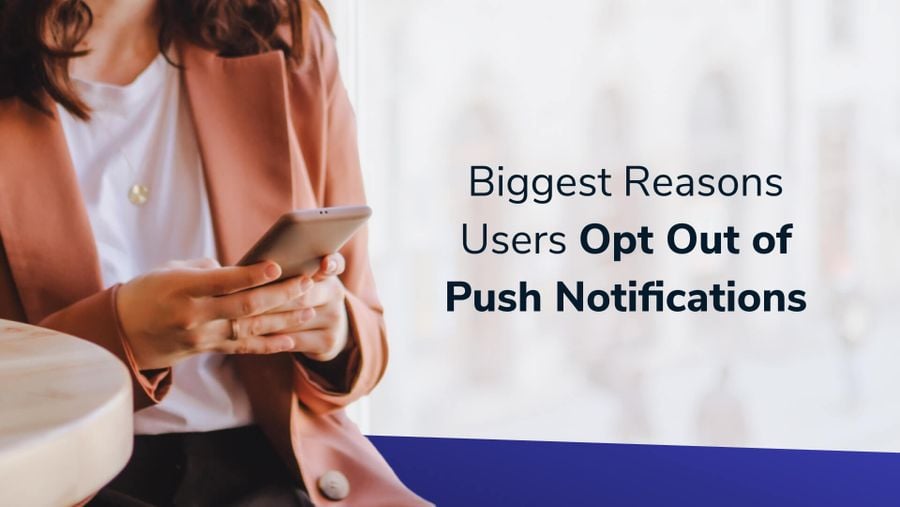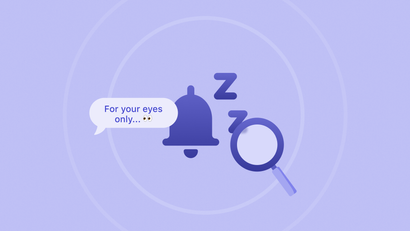Why Do People Opt Out of Push Notifications?
In today’s competitive mobile ecosystem, push messaging campaigns are ever more critical to your app’s long-term survival. However, your push campaigns can deliver no value when users decide to opt out of these communications.
The greater number of users you convince to opt into this channel, the greater the benefits you’ll gain for your app. On the flip side, failing to get users to opt in at an early touchpoint or losing subscribers over time can negatively impact your app’s engagement and retention metrics.
That’s why it’s important to unpack the factors that cause some users opt out of this channel. Let’s get into some common reasons this can occur.
Receiving Too Many Messages
Inundating your users with too many messages is a common pitfall in the mobile marketing space. With a highly sensitive channel like push notifications, it’s easy to over-message your users, which can lead them to get frustrated and opt out. To avoid this outcome, you’ll want to optimize the frequency of your notifications based on the utility you’re providing and users’ individual tolerance levels for your communications.
An easy way to ensure you’re not messaging your users too frequently is to look at your engagement rates and adapt accordingly. Run tests to understand the optimal frequency for heightened engagement with your push campaigns.
The line between enough and too many messages will depend largely on your app vertical and the type of utility you have for your users. For example, a fitness and lifestyle app that encourages users to routinely enter data throughout the day should be messaging their audience more frequently than a travel app.
If you choose a messaging provider with robust capabilities, you may have access to built-in features that can help you avoid this pitfall, and avoid the subsequent opt-outs that can occur.
Frequency Capping: Frequency capping controls allow you to define the maximum number of push notifications that can be sent to a user within a specific time period. You can set a messaging limit based on intervals of an hour, day, or week, which will limit sends on a rolling basis. Most companies can benefit from frequency capping, especially those that typically send a high volume of notifications or manage multiple campaigns.
No Longer Interested in the Brand
Another reason users could be opting out of your campaigns could be that they are simply losing interest in your brand. You could be doing everything right within your marketing strategy, but unfortunately, some users will churn because your product or service no longer serves their needs or interests. In this case, their opt-out isn’t a direct sign of a failure in your push messaging strategy, but rather a deeper issue around the function of your offering.
Updates Aren’t Meaningful or Relevant
Sending your users updates that aren’t meaningful to your users shows them that you don’t understand their needs. If your messages aren’t providing direct value to your users, they’re only going to annoy or disrupt your audience, causing increased opt-outs.
To remedy this issue, you should prioritize sending notifications that are relevant to a user’s buying stage, their known preferences, their specific behaviors, and their personal information.
Sending meaningful and relevant updates is easier said than done. Targeting your users appropriately requires charting your customers’ key interactions with your company across multiple channels and throughout their lifecycle.
Messages are All Sales-Motivated
A common reason users might be opting out of your push notifications is that your messages are purely marketing-driven. Avoid the mistake of sending only sales-related push notifications to your users, because this is a shortsighted tactic that’s likely to backfire and cause users to opt-out. If you’re only sending notifications aimed at prompting a direct sale, you should go back to the drawing board and do some research on the buyer’s journey.
Although it can be useful to send sales or promotional messages within your strategy, you should balance these types of notifications with push notifications that serve a user’s needs throughout their journey. Non-marketing messages, also known as transactional messages, are necessary and urgent communications to your end users or customers.
Notifications Are Broad and Not Personalized
With the advancement of marketing automation solutions, consumers are showing an increased appetite for personalization and increased sensitivity to broadly and sloppily targeted messages from brands. Failing to deliver on this expectation is not only a missed opportunity, but it can lead to direct opt-outs.
This means that if you don’t take care to segment and personalize your push audience, you can easily prompt users to opt right out of your communications in this channel. If your opt-out rates are high, you may want to evaluate your current level of attention to segmentation and personalization.
Personalized messaging saves your users’ time by grabbing their attention with information, updates, or deals that are directly of interest and actionable. Getting key messages in front of your users improves their in-app experience and allows them to engage with your company in a way that's useful to them.
Message personalization is not only associated with lower opt-out rates, but also higher Open and Click-Through Rates.
Outreach Happened Long After Initial Signup
Another reason users may be opting out of your messaging is that they haven’t heard from you after their initial opt in. Requesting permission to message your users and then failing to follow up promptly with a subsequent message is a sloppy move. Make sure that you have a game plan to engage with users in a timely manner after requesting their permission to communicate with them. Remaining consistent with the expectations you set after the fact is important for trust-building and long-term loyalty. To avoid this pitfall, establish an onboarding or welcome push series to excited users after they’ve opted in.
Notifications are Mistimed
Another common mistake that could be leading to push opt-outs is that your notifications are poorly timed. Think about it. How would you feel if you woke up to a push notification at 2 am asking you to upgrade to an app’s one-year subscription plan? You’d definitely be unlikely to buy the subscription, and you’d also probably be annoyed enough to unsubscribe from the app’s communications in general.
Scenarios like this highlight exactly why you should monitor the timing of your push notification campaigns. If you choose a provider that has built-in features that can help you avoid mistimed notifications, you can avoid unnecessarily elevating your push opt-out rates.
OneSignal, for example, automatically optimizes the delivery time of your notifications based on when a user most recently used your app or website through a feature called Intelligent Delivery. This feature’s algorithm determines when a user is most likely to open your app and delivers notifications accordingly.
Tips to Get Users to Opt Back In to Push Notifications
1. Give Them the Opportunity to Sign Back Up
The simplest way to address the issue of opt-outs is by giving these users a way to sign up again. Who knows? Maybe after demonstrating the value of your platform or product, users will have more of a reason to engage with you through push notifications. You can encourage users to reenable push by executing a re-permission campaign.
You can execute a re-permission campaign using in-app messages or through other channels. In-apps are an excellent way to reach your mobile-first audience while they’re actively engaged with your platform. With in-apps you can explain to users what you plan to send them before they decide to grant permission, educate them around app functionality, or engage your users about your product.
With in-apps, you also have a mechanism of engaging your users with up to 10 screens of customizable content, which gives you plenty of room to express your message before asking for push permission a second time.
Another strategy to consider for re-permission campaigns is using the incentives that we’ll discuss in the latter part of this article. Request permissions for your app without making any code changes. Improve opt-in rates by explaining to users what you plan to send them before they decide to grant permission,
2. Utilize a Different Channel to Engage With Them
Every user is different, and it’s possible that push notifications are not everyone’s cup of tea. Some users intend on downloading your app, but prefer to use your platform without the intention of opting into notifications. In this case, a user may prefer to be catered to in a different way.
By explicitly asking about a user’s communication preferences, you can ensure you’re messaging them on their preferred channel or channels. If push notifications aren’t their jam, you can give them the option to receive your brand communications via text, email, or web push.
Luckily, with an Omnichannel messaging provider, you’ll have the option to easily message your users across a variety of mediums, adapting to their explicit or implicit preferences.
- Email: Send long-form transactional or marketing messages to users. Provide depth and context to your message that is difficult to achieve with short-form copy.
- SMS: Reach users front and center on their cell phones with urgent and sensitive messages from your brand.
- Web Push: Reengage users on their desktops even after they leave your site. This type of messaging works on Chrome, Safari, Firefox, Edge, Opera, and Yandex.
3. Offer Incentives
When it comes to getting users to take a desired action, such as opting back into notifications, the psychology is simple. Offering an incentive or reward in exchange for an opt-in is a surefire way to get more users to give your messaging a second chance.
Incentive-based marketing techniques are a tried and true way of coaxing users in the right direction because offering your users something of value in exchange for a small favor appeals to our basic human instincts. In other words, who doesn’t like free stuff?
For a Saas brand, your incentive could be a free trial. For a food delivery app, your incentive could be a free order from a local restaurant.
Common types of marketing incentives you can provide include the following..
- Loyalty Programs: 69 percent of consumers say receiving loyalty points impacts their choice of retailer. You can offer loyalty points to your users in exchange for their attention to your push campaigns.
- Special Feature Access: giving your users exclusive access to gated features in exchange for their opt in is a convincing tactic.
- Free Items or Discounts: A classic incentive you can provide to your users is a free item or a hot discount. This tactic could work well well for an eCommerce or gaming app, for instance.
Getting Started with OneSignal
OneSignal is designed to help you send notifications and seamlessly manage your user communication across a variety of channels, including mobile push notifications, web push notifications, bulk SMS, in-app messaging, and email. Our platform is quick to set up and makes it easy to send eye-catching messages without doing any development work. If you don't have a OneSignal account, you can create one for free and start sending push notifications to your users today. Don't take our word for it — simply sign up and see for yourself!
Create a Free Account



